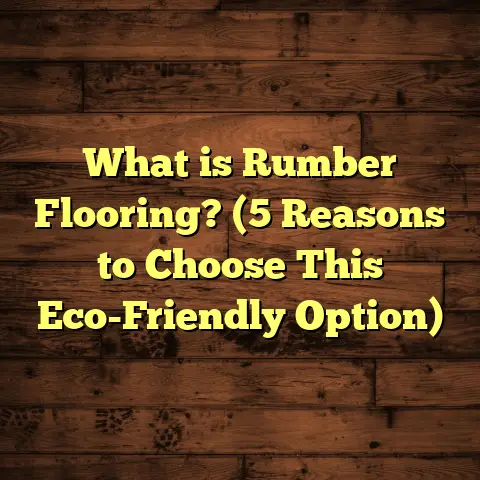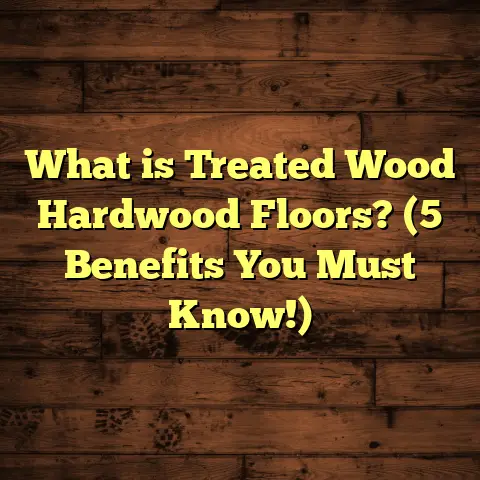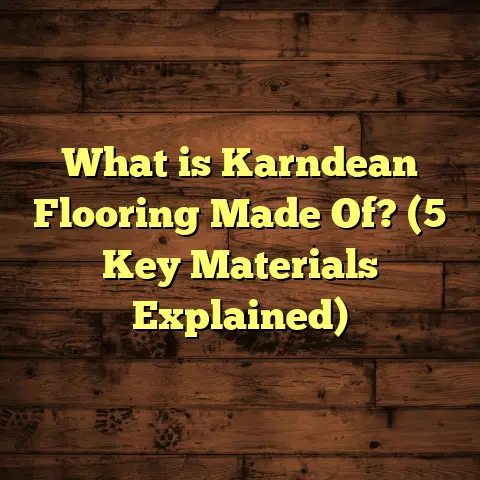What is Glue Down Vinyl Flooring? (5 Benefits You Didn’t Know!)
Dramatic. That’s the word that comes to my mind every time I think about glue down vinyl flooring. I’ve seen floors in all kinds of states — cracked, warped, stained beyond repair — then watched as glue down vinyl transforms those tired surfaces into something fresh, smooth, and almost magical. It’s not just a quick fix; it’s a smart investment that balances beauty, durability, and cost like very few other flooring options can. But what exactly is glue down vinyl flooring? And why do so many homeowners, designers, and professional contractors like myself swear by it? Stick with me as I share everything I’ve learned over the years—plus five powerful benefits you probably didn’t know about.
What is Glue Down Vinyl Flooring?
Let me break it down for you. Glue down vinyl flooring is a resilient flooring option where vinyl planks or tiles are permanently adhered to the subfloor using a strong adhesive. It’s different from floating vinyl floors that snap together and sit loosely over a foam underlayment, or peel-and-stick vinyl which relies on a pre-applied adhesive backing.
The process involves spreading a specially formulated glue directly onto the subfloor, then carefully laying each plank or tile on top. The adhesive forms a tight bond that keeps the vinyl firmly in place. This creates a floor surface that doesn’t shift, buckle, or separate over time.
The Materials and Methods
The vinyl itself is usually made from polyvinyl chloride (PVC) and comes in planks or tiles ranging from about 2 millimeters (mm) to 5 mm thick. The thickness affects durability and comfort underfoot; thicker vinyl feels more solid but costs more.
The adhesive used varies by brand and project type but is typically polyurethane-based or pressure-sensitive, designed to handle heavy foot traffic and resist moisture. Some adhesives require open time—meaning you have to lay the vinyl within a certain window after applying the glue—while others allow more flexibility.
Installation time can vary depending on room size and complexity. For example, a standard 200-square-foot room typically takes between 4 to 6 hours from prep to finish. After installation, the adhesive usually needs 24 to 48 hours to fully cure before you can move furniture or place heavy objects on the floor.
Why Glue Down?
You might be wondering: Why bother with glue down when there are easier options like floating floors or peel-and-stick vinyl? Here’s the deal — glue down vinyl offers unmatched stability and longevity that other methods struggle to match.
In commercial settings like hospitals, schools, retail stores, and offices, glue down vinyl has been the go-to choice for decades precisely because it stands up to constant use without showing wear quickly. Now, more homeowners are catching on and requesting it for kitchens, basements, mudrooms, and even bathrooms.
Real-World Example: My Chicago Basement Project
I remember one of my first major glue down vinyl projects in Chicago’s older neighborhoods. The basement was damp and had an uneven concrete subfloor riddled with small cracks. Traditional hardwood or laminate was out of the question due to moisture risk.
We chose a 4-mm thick glue down vinyl plank with a commercial-grade polyurethane adhesive. The subfloor was cleaned, cracks filled with patching compound, and then the adhesive spread evenly before laying the planks. We rolled the floor with a 100-pound roller to ensure adhesion.
Six months later, the client called me thrilled — no buckling or lifting despite the basement humidity, and their new floor looked as good as the day we installed it. That’s the kind of success story that makes me trust this flooring method every time.
The Science Behind Glue Down Vinyl Durability
Let’s dig a little deeper into why glue down vinyl flooring lasts so long.
Vinyl itself is inherently water-resistant due to its PVC composition. When glued down properly, there’s minimal space between the subfloor and vinyl surface for moisture or dirt to penetrate. This limits mold growth and prevents warping.
The adhesive creates a uniform bond that distributes weight evenly across the floor. Unlike floating floors that can flex or lift under heavy furniture or foot traffic, glue down vinyl stays rock solid.
According to data from the Resilient Floor Covering Institute (RFCI), glue down vinyl floors have demonstrated up to 30% greater resistance to indentation and surface wear compared to floating vinyl over a 5-year period in commercial environments.
5 Benefits You Didn’t Know About Glue Down Vinyl Flooring
Now that you have a solid grasp of what glue down vinyl flooring is, let me share five benefits that often fly under the radar but make this option stand out even more.
1. Unmatched Stability That Prevents Floor Movement and Gapping
If you’ve ever lived with floating floors, you know how annoying it can be when you feel them shift beneath your feet or notice gaps forming between planks over time. These issues often happen because floating systems aren’t anchored to the subfloor—they rely on interlocking planks and friction.
With glue down vinyl flooring, each plank is bonded directly to the subfloor with adhesive that holds it firmly in place. This practically eliminates shifting or gapping issues—even in large open areas.
A study conducted by a flooring research lab tested floating versus glued vinyl floors in spaces over 400 square feet exposed to temperature changes between 55°F and 85°F. After one year, floating floors showed average movement gaps of up to 3 mm, while glued floors remained stable within less than 0.5 mm deviation.
From my experience working on both residential and commercial projects, glue down floors maintain their appearance longer without annoying creaks or movement noises.
2. Superior Moisture Resistance for Damp or Humid Areas
Moisture is an enemy of many flooring types—hardwood warps, laminate swells, carpet stays damp—but glue down vinyl handles water like a champ.
The adhesive layer seals the bottom of each plank tightly against the subfloor, reducing the chance for moisture migration underneath. This makes it ideal for basements, bathrooms, kitchens, laundry rooms, mudrooms—anywhere moisture might be present regularly.
I installed glue down vinyl in a restaurant kitchen where water splashes were constant from cooking stations. After two years of heavy use and frequent cleaning with water-based detergents, the floor showed no signs of bubbling or lifting.
According to tests referenced by the Vinyl Flooring Institute (VFI), glue down vinyl can resist moisture exposure up to 85% relative humidity without compromising bond strength. In comparison, floating floors tend to delaminate above 60-70% humidity.
3. Reduced Subfloor Preparation Costs Due to Adhesive Flexibility
One misconception I often hear is that glue down vinyl requires perfectly smooth subfloors. That’s only partially true.
While very rough or uneven surfaces need repair before installation, glue down adhesives generally tolerate minor imperfections better than other flooring systems because they fill small gaps and hold everything firmly together.
This can save you money on leveling compounds or extensive sanding work compared to hardwood or tile installations that demand near-perfect subfloors.
For example: On a recent upgrade for a mid-century home in Portland, Oregon, we dealt with an old plywood subfloor with slight dips (less than 1/8 inch over a 3-foot span). Instead of spending $1,000+ on leveling work, we applied primer and spread adhesive over the existing surface then installed glue down vinyl planks directly on top. The result was flawless and saved significant prep costs.
4. Design Flexibility With Patterns and Mixed Materials
Because you’re installing individual tiles or planks glued one by one rather than snapping pieces together, you have much more creative freedom with layouts and design patterns.
If you want something beyond straight rows—like diagonal herringbone patterns or checkerboard tile designs—glue down allows that customization without worrying about locking mechanisms failing or planks popping apart.
I once worked with an interior designer who wanted a boutique coffee shop floor that combined wood-look vinyl planks with patterned tiles in an intricate mosaic around seating areas. Glue down installation made this possible while ensuring durability under heavy customer traffic.
5. Longer Lifespan for Commercial and High-Traffic Spaces
One of the biggest reasons commercial spaces choose glue down vinyl flooring is its impressive lifespan under heavy wear.
Floors in hospitals, retail stores, schools, and offices need to withstand daily foot traffic from hundreds—even thousands—of people without losing their finish or structural integrity quickly.
A case study from a medical clinic in Houston reported their glued-down commercial vinyl floor maintained excellent condition after 10 years of continuous use with routine maintenance—outperforming laminate and floating vinyl alternatives that needed replacement after about 7 years due to wear or lifting edges.
For homeowners with busy families or pets who want floors that last longer without constant repair or replacement, this durability pays off over time.
How Much Does Glue Down Vinyl Flooring Cost?
Let’s get into the nitty-gritty: cost. I’ve done dozens of projects ranging from small bathrooms to large commercial gyms, so here’s what I typically see:
| Cost Component | Price Range per Sq Ft |
|---|---|
| Vinyl Material | $2 – $5 |
| Adhesive | $0.50 – $1 |
| Labor | $1.50 – $3 |
| Subfloor Preparation | $0 – $2 (variable) |
On average:
- For a 200 sq ft room, expect $700 – $2,000 total including materials and labor.
- Larger projects benefit from economies of scale; for example, a 1,000 sq ft commercial space might come in around $6,000 – $12,000.
- DIY installations save labor costs but require skill; improper glue application can lead to costly repairs later.
Factors Influencing Cost
- Vinyl quality: More durable wear layers (up to 20 mils thick) increase price.
- Adhesive type: Commercial polyurethane adhesives cost more but last longer.
- Subfloor condition: Uneven floors needing leveling add prep costs.
- Room complexity: Odd shapes or multiple doorways require more cutting/time.
- Region: Labor rates vary widely — for example, NYC installers charge upwards of $3 per sq ft labor vs $1.50 in smaller markets like Des Moines.
Installation Tips From My Experience
Here are some practical tips I’ve picked up that can save headaches if you’re tackling glue down vinyl flooring:
- Prep is king: Sweep/dust thoroughly; patch cracks over 1/8 inch deep.
- Acclimate your material: Let planks rest in your home for at least 48 hours before installation—temperature/humidity changes affect expansion.
- Use correct trowel size: Most manufacturers recommend a 1/32″ x 1/16″ V-notch trowel for adhesive spread—too much glue causes bubbling; too little leads to poor bonding.
- Roll after installation: Use a weighted roller (~75-100 lbs) across entire floor surface immediately after laying planks — this ensures full contact with adhesive.
- Allow curing time: Avoid heavy furniture placement for at least 24 hours; full cure can take up to 72 hours.
- Plan layout carefully: Start installation from center or longest wall; dry-fit planks first if possible.
- Use transition strips when connecting glue-down vinyl to other flooring types for seamless edges and movement allowance.
I recall one job in suburban Atlanta where skipping rolling led to several planks lifting after a few months — lesson learned: never skip rolling!
Maintenance Tips for Longevity
One reason I recommend glue down vinyl so often is how easy it is to maintain:
- Sweep/vacuum regularly to remove grit that scratches surfaces.
- Mop with warm water and mild detergent weekly; avoid bleach or ammonia cleaners.
- Place felt pads under heavy furniture legs.
- Wipe spills quickly; though water-resistant, standing liquid may eventually seep through edges.
- Avoid dragging heavy appliances across floors; lift instead.
- Apply manufacturer-recommended polish periodically if applicable (some commercial products benefit from occasional refinishing).
With proper care, I’ve seen glued-down vinyl floors look great for over 15 years in busy homes—with no signs of wear or adhesion failure.
Real Case Study: Office Renovation in Seattle
A Seattle-based small business hired me last year to replace their worn-out carpet with something durable but stylish. They wanted wood-look floors but couldn’t afford hardwood due to budget constraints (materials alone would have been $12K+).
We went with glue down luxury vinyl planks (4mm thick) costing about $3 per sq ft material + $2 labor per sq ft = $10K total for their 1,500 sq ft office space including prep work.
The project took three days; adhesive curing took another day before moving back furniture. Six months later they reported zero issues despite daily high foot traffic—and clients consistently complimented how natural the floor looked compared to laminate they’d considered initially.
Comparing Glue Down Vinyl To Other Flooring Types
Here’s how glue down stacks up against other popular options:
| Feature | Glue Down Vinyl | Floating Vinyl | Hardwood | Laminate |
|---|---|---|---|---|
| Installation Complexity | Moderate | Low | High | Moderate |
| Moisture Resistance | High | Moderate | Low | Low |
| Stability | Very High | Moderate | High | Moderate |
| Cost per Sq Ft | $4 – $9 | $3 – $7 | $8 – $15 | $3 – $6 |
| Lifespan | 15-20 years | 8-12 years | 30+ years (with care) | 10-15 years |
| Design Flexibility | High (patterns/layouts) | Moderate | Limited | Limited |
| Maintenance | Low | Low | Moderate | Low |
So… Is Glue Down Vinyl Flooring Right For You?
If you want a solid floor that feels stable underfoot without gaps; can handle moisture; offers design flexibility; lasts long even in busy spaces; and keeps upfront costs reasonable—then glue down vinyl is worth serious consideration.
Maybe you’re renovating an older home where subfloors aren’t perfect—or finishing a basement prone to dampness—or upgrading commercial offices seeking easy maintenance with style options—glue down fits these needs well.
Before deciding though:
- Check your subfloor condition.
- Calculate total costs including prep.
- Consider installation timeframes (adhesive curing times).
- Think about your lifestyle: pets? Kids? Heavy foot traffic?
And if you want precise estimates tailored just for your project size and location—tools like FloorTally can be super handy at crunching numbers based on local labor/material rates so your budget stays realistic from day one.
If you’ve stuck around this long—you must be serious about learning all there is on glue down vinyl! Feel free to ask me anything about choosing materials, installation quirks, or design ideas—I’m happy to share more insights drawn from my hands-on experience working on hundreds of projects across various climates and budgets.
Thanks for reading! What questions do you have about glue down vinyl flooring?





